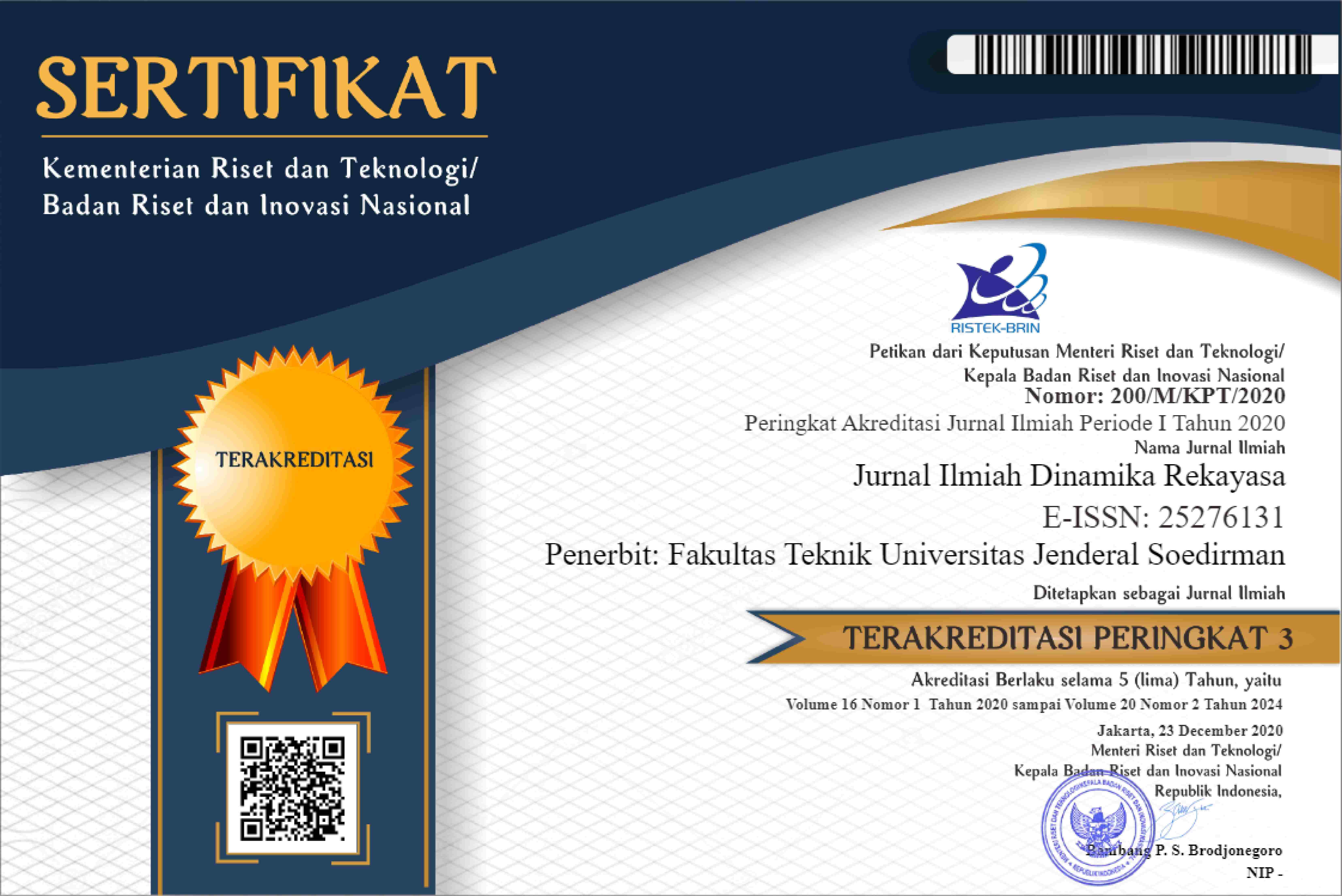Achievement and Cost Efficiency Analysis of Implementing Green Construction on A Public Service Mall Construction in the City of Tegal
DOI:
https://doi.org/10.20884/1.dinarek.2024.20.2.71Keywords:
green, construction, questionnaire, costAbstract
Green construction is a concept in the planning and implementation stages of construction aimed at reducing the negative environmental impacts of construction activities. The Public Service Mall Building Project in Tegal City is a building project that requires costs from planning to maintenance. The construction of a project certainly requires substantial costs. The objective of this research is to evaluate the achievements and determine the cost efficiency of using the green construction concept. This research was conducted through a preliminary survey of the involved parties who understand the green construction concept to identify the most applied categories, namely the use of refrigerants without Ozone Depleting Potential (ODP), regional materials, environmental control over cigarette smoke, and pollution from construction activities. This type of research is qualitative, with data collection techniques carried out through interviews and direct observation. The data analysis for cost efficiency involves comparing green construction concepts with non-green construction concepts. The results of the benchmark measurements for using refrigerants without Ozone Depleting Potential (ODP), regional materials, and environmental control over cigarette smoke in the green construction concept achieved 100%, while the benchmark measurement results for green construction concerning pollution from construction activities achieved 50%. Based on the cost usage analysis in the upper structure construction of the Public Service Mall Building in Tegal City, the cost usage of the GC concept is 9.25% more efficient than the conventional concept.
Downloads
References
L. B. Setyaning, “Pengembangan Aktivitas Green Construction, Green Recycling, dan Green Warehousing Sebagai Bagian dari Green Supply Chain Management di Proyek Konstruksi,” Semesta Teknika, vol. 26, no. 1, hlm. 21–27, Mei 2023, doi: 10.18196/st.v26i1.16490.
T. I. Praganingrum, N. L. M. A. M. Pradnyadari, I. B. Suryatmaja, I. G. A. G. Suryadarmawan, dan N. N. I. S. Saraswati, “Identifikasi Penerapan Green Construction pada Proyek Konstruksi,” Jurnal Permukiman, vol. 18, no. 1, hlm. 45–52, 2023.
GBCI, “PERANGKAT PENILAIAN GREENSHIP untuk BANGUNAN BARU Versi 1.2,” 2013. Diakses: 20 Maret 2024. [Daring]. Tersedia pada: https://www.gbcindonesia.org/
Ervianto, Selamatkan Bumi Melalui Konstruksi Hijau. Andi Yogyakarta, 2012.
C. Alverina dan J. S. Tamtana, “Analisis biaya pelaksanaan proyek konstruksi gedung bertingkat dengan konsep konstruksi hijau,” JMTS: Jurnal Mitra Teknik Sipil, hlm. 245–254, 2020.
I. Kurniawan dan A. E. Husin, “Analisis Faktor Yang Berpengaruh Dalam Penerapan Konsep Green Pada Bangunan Flour Mill Plant Menggunakan Sem-Pls,” J Teknol, vol. 15, no. 2, hlm. 275–286, 2023.
S. Sudarman, M. Syuaib, dan N. Nuryuningsih, “GREEN BUILDING: SALAH SATU JAWABAN TERHADAP ISU SUSTAINABILITY DALAM DUNIA ARSITEKTUR,” TEKNOSAINS: MEDIA INFORMASI SAINS DAN TEKNOLOGI, vol. 15, no. 3, hlm. 329, Des 2021, doi: 10.24252/teknosains.v15i3.22493.
S. Suripto, M. H. Abdi, dan E. H. Manurung, “Evaluasi Penerapan Green Construction Proyek Pembangunan Gedung Rektorat Kampus UIII,” Jurnal Talenta Sipil, vol. 5, no. 1, hlm. 134–143, 2022.
J. P. Kembaren, S. A. K. A. Uda, dan A. B. P. Gawei, “KAJIAN KENDALA IMPLEMENTASI KONSEP GREEN CONSTRUCTION PADA KONTRAKTOR DI KOTA PALANGKA RAYA,” Jurnal Teknika: Jurnal Teoritis dan Terapan Bidang Keteknikan, vol. 7, no. 1, hlm. 19–27, 2023.
F. Dewantoro, R. A. Mahardika Putra, D. Pratiwi, G. Pramita, dan J. Jupriyadi, “PELATIHAN DESIGN GREEN BUILDING PADA SMK NEGERI 1 TRIMURJO KABUPATEN LAMPUNG TENGAH,” Journal of Social Sciences and Technology for Community Service (JSSTCS), vol. 3, no. 2, hlm. 317, Sep 2022, doi: 10.33365/jsstcs.v3i2.2183.
N. A. Maulidianti, E. Mulyani, dan S. M. Nuh, “Identifikasi Konsep Green Construction Pada Perencanaan Gedung Perpustakaan Pusat Universitas Tanjungpura,” JeLAST: Jurnal PWK, Laut, Sipil, Tambang, vol. 8, no. 1, 2021.
G. R. Novalia, “Analisis Kategori Green Construction Proyek Pembangunan Tower Venetian Grand Sungkono Lagoon”,” Skripsi, ITS Surabaya (unpublished), 2016.
R. M. Putra, M. A. Wibowo, dan S. Syafrudin, “APLIKASI GREEN BUILDING BERDASARKAN METODE EDGE,” Wahana Teknik Sipil: Jurnal Pengembangan Teknik Sipil, vol. 25, no. 2, hlm. 98, Des 2020, doi: 10.32497/wahanats.v25i2.2155.
M. Rajhab, M. Kevin Hary Pratama, S. Supardi, dan S. Fatmah Arsal, “Volume 4 Nomor 2 April 2022 Evaluasi Penerapan Green Construction Pada Proyek Pembangunan Rumah Sakit Pendidikan UIN Alauddin Di Kota Makassar,” 2022. Diakses: 24 Maret 2024. [Daring]. Tersedia pada: https://jurnal.ft.umi.ac.id/index.php/JILMATEKS/article/view/526
H. S. Pratama, R. K. Anggraeni, A. Hidayat, dan R. R. Khasani, “Analisa perbandingan penggunaan bekisting konvensional, semi sistem, dan sistem (PERI) pada kolom gedung bertingkat,” Jurnal Karya Teknik Sipil, vol. 6, no. 1, hlm. 303–313, 2017.
R. A. Dewi dan R. A. Sembiring, “Analisa Perbandingan Penggunaan Bekisting Konvensional dan Sistem Pada Gedung Bertingkat,” vol, vol. 8, hlm. 9–14, 2022.





